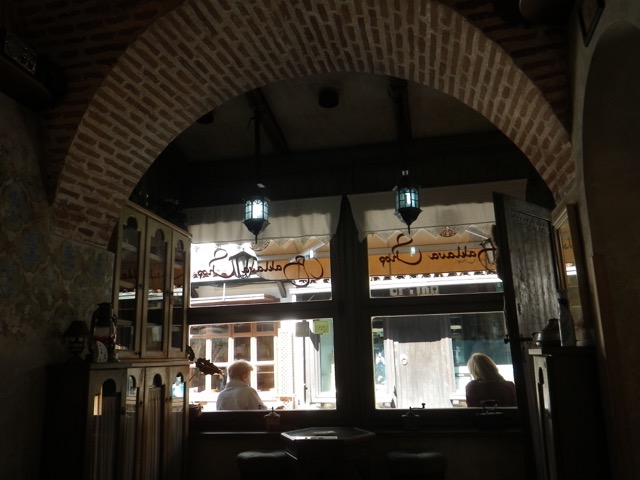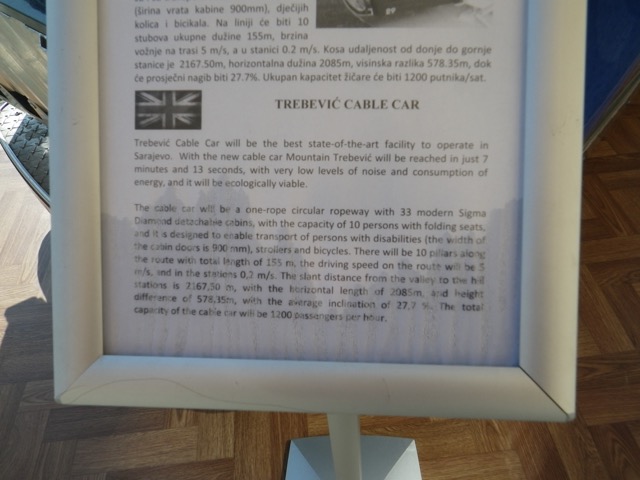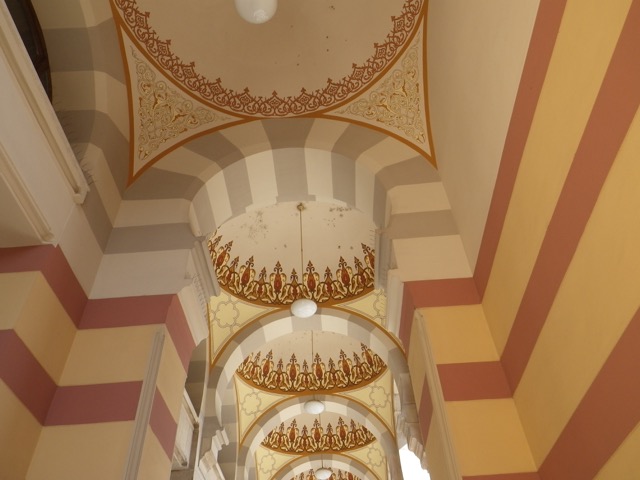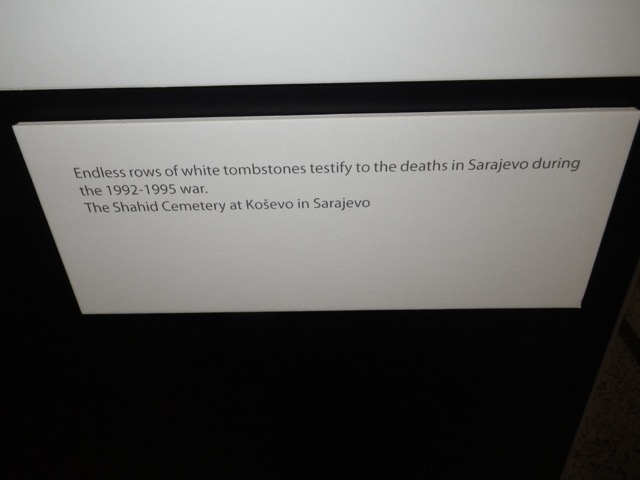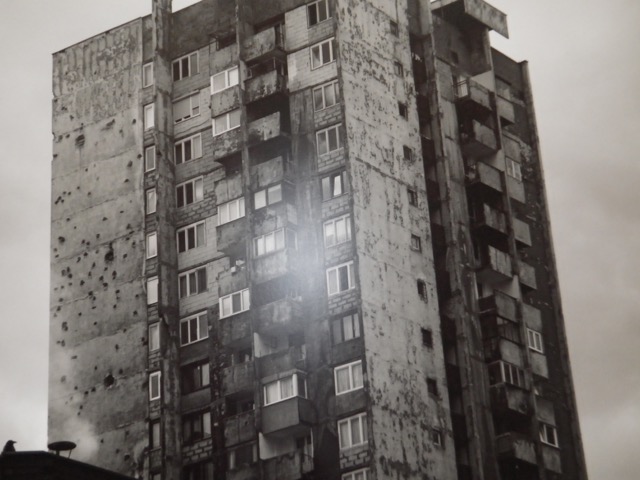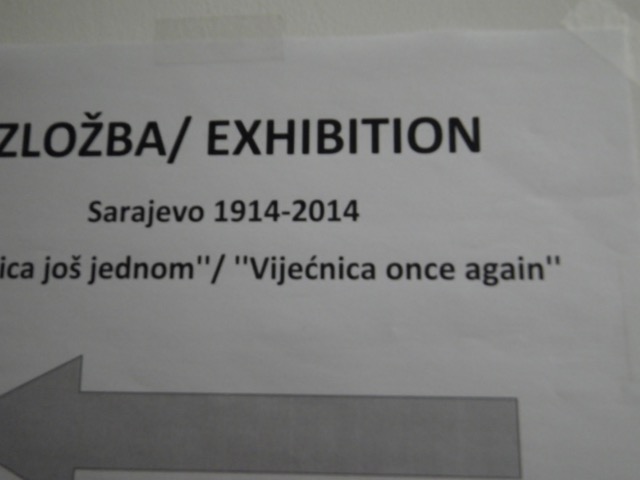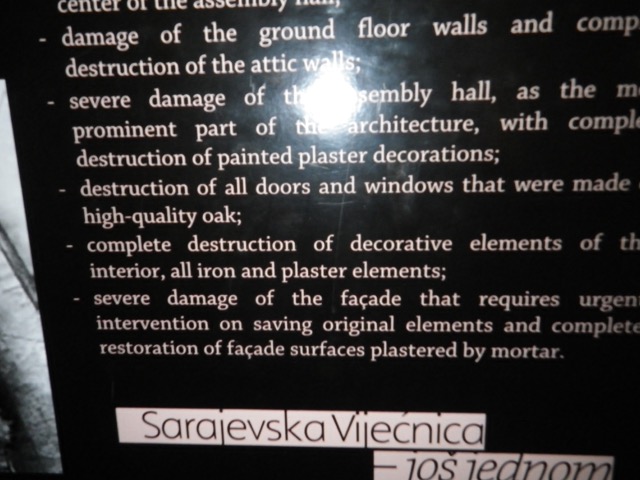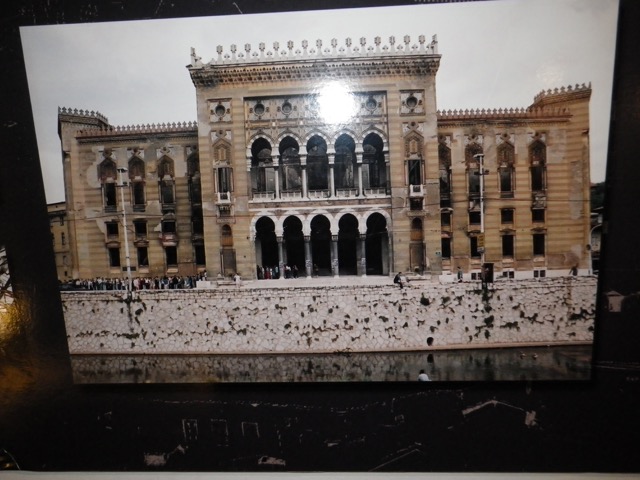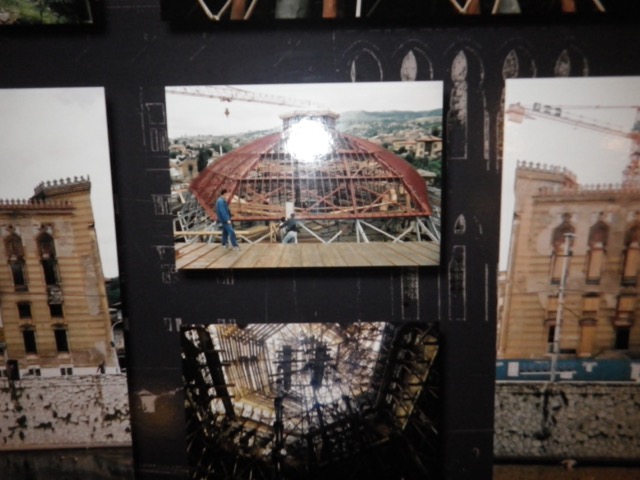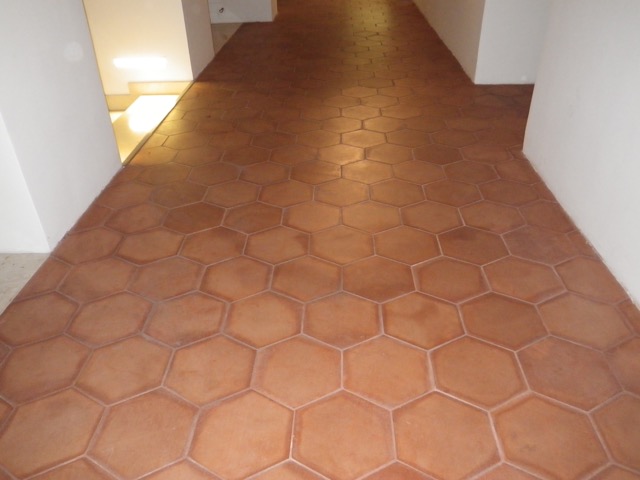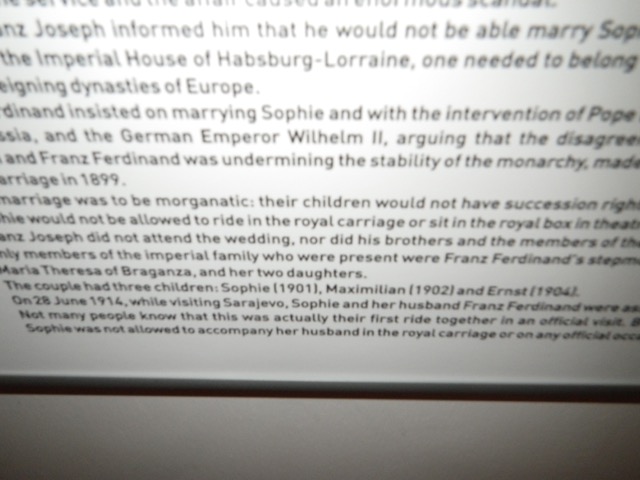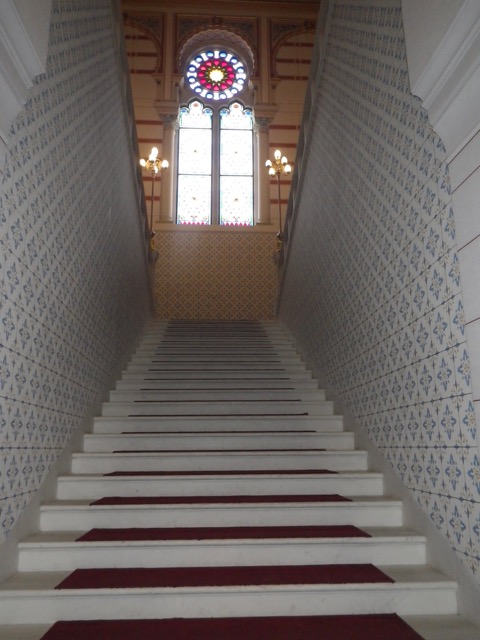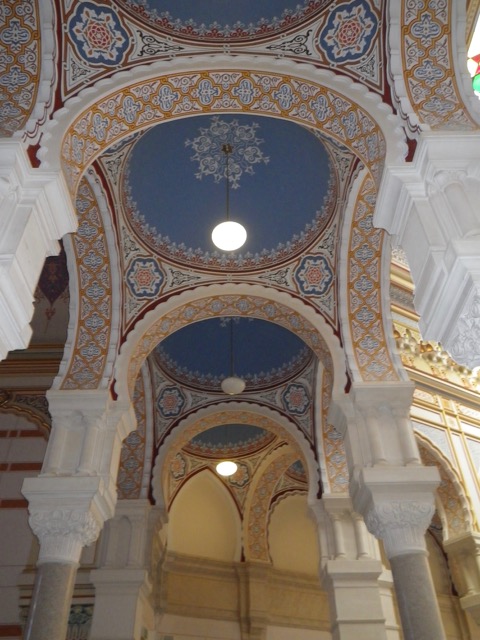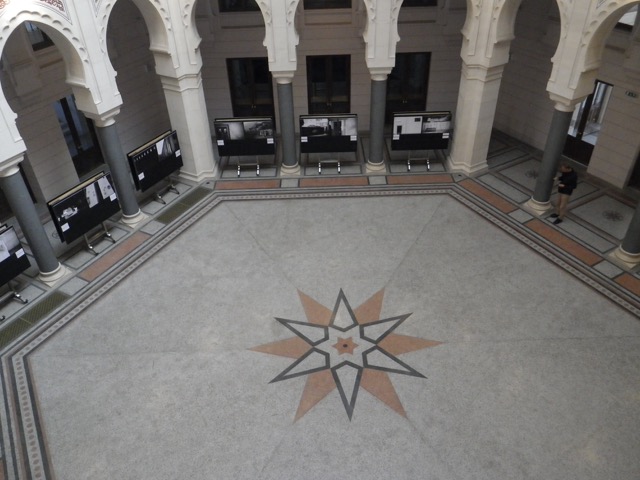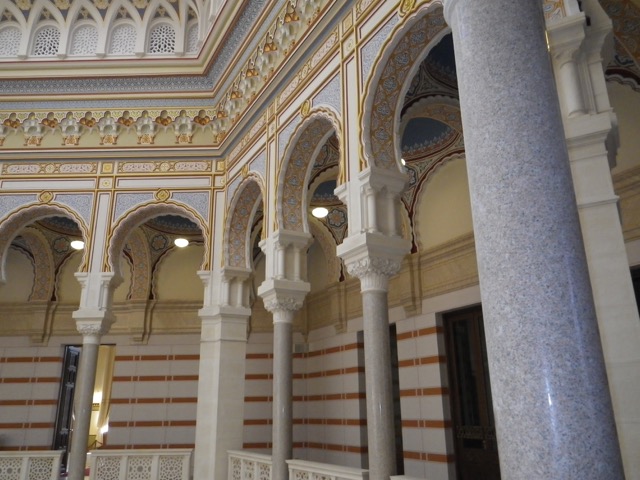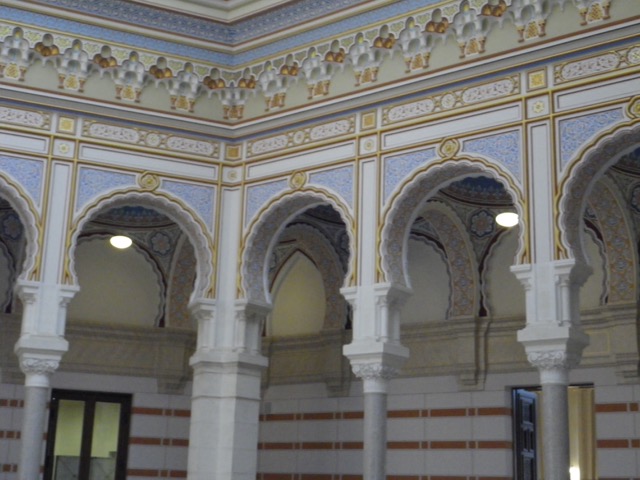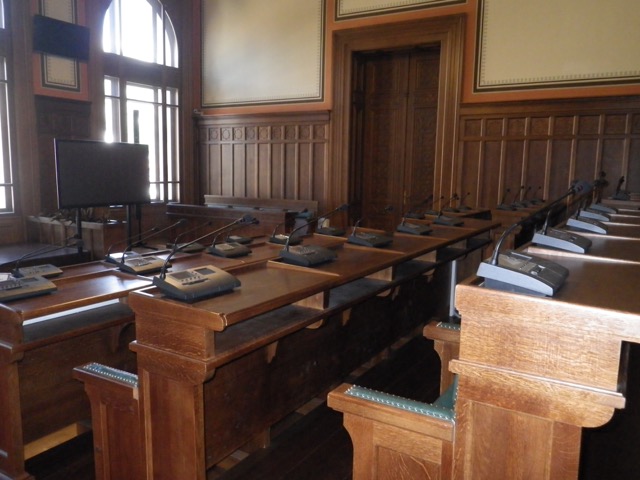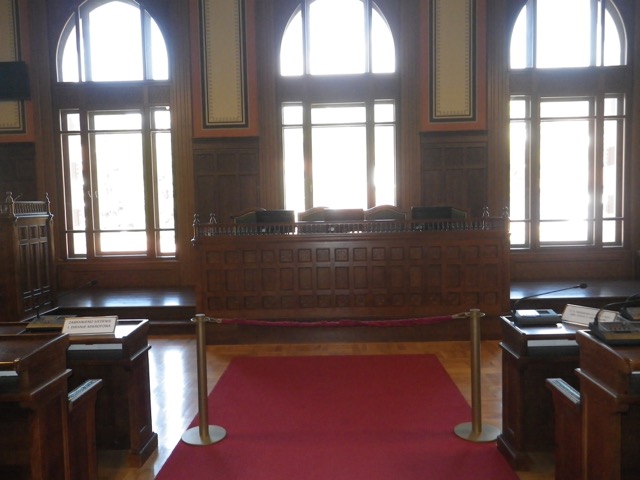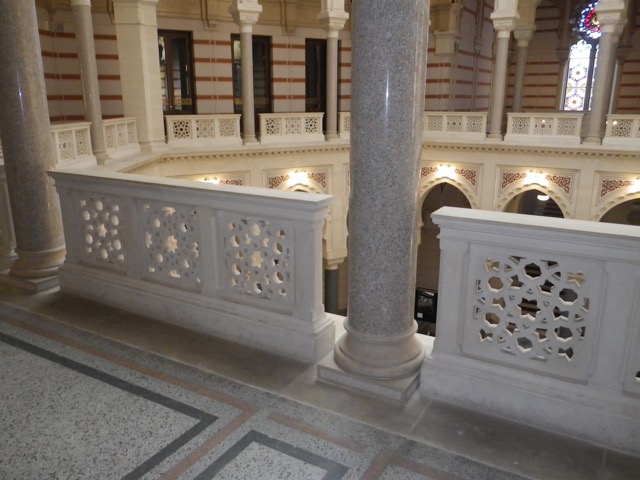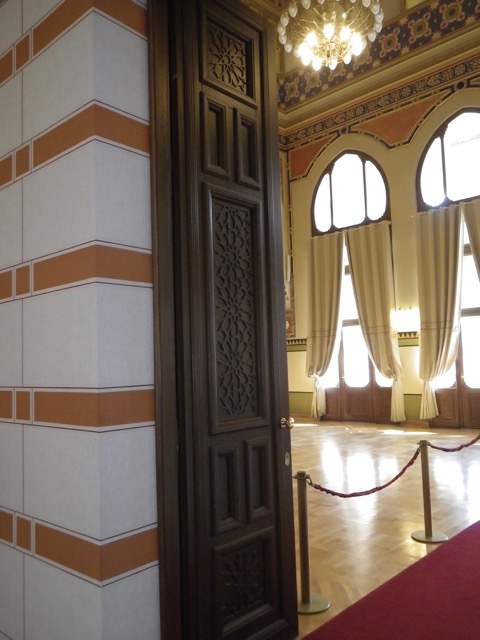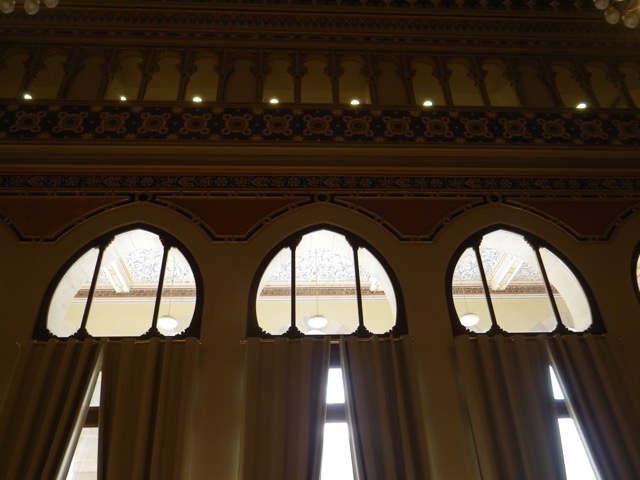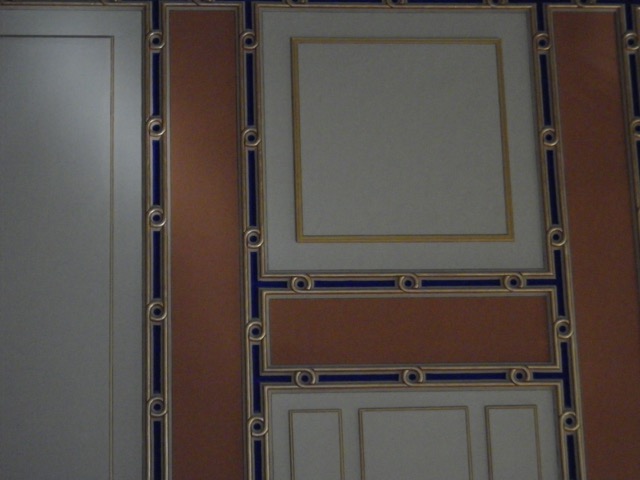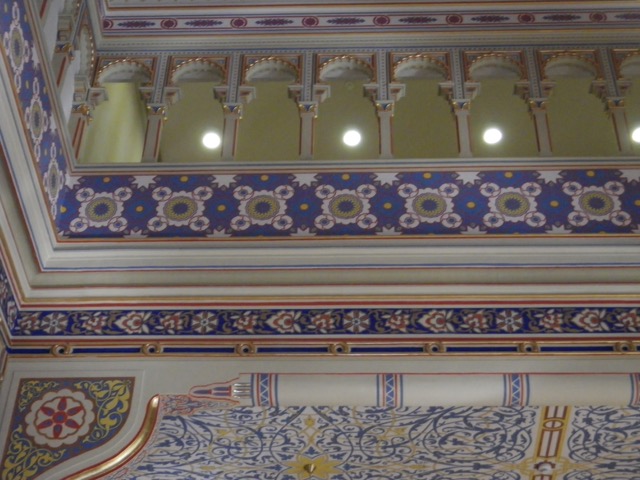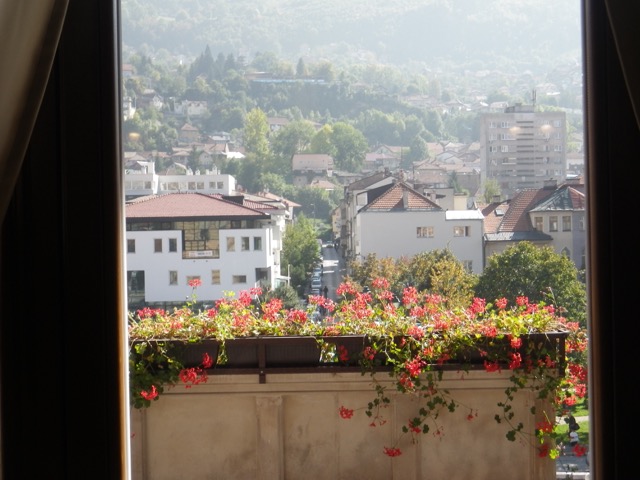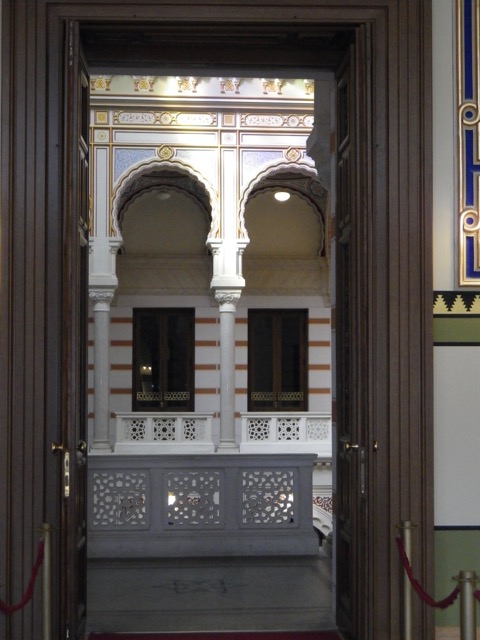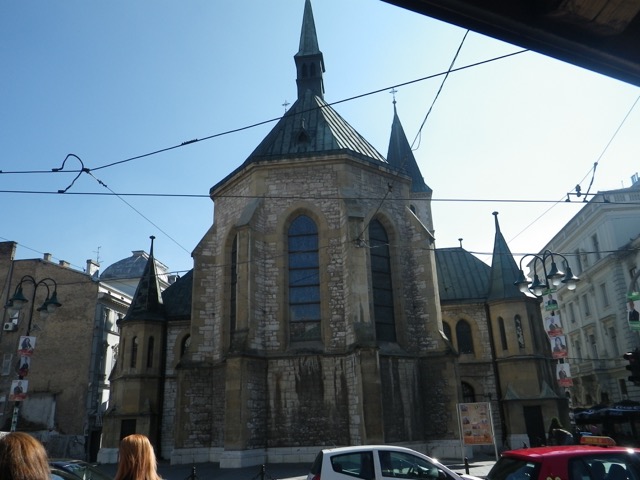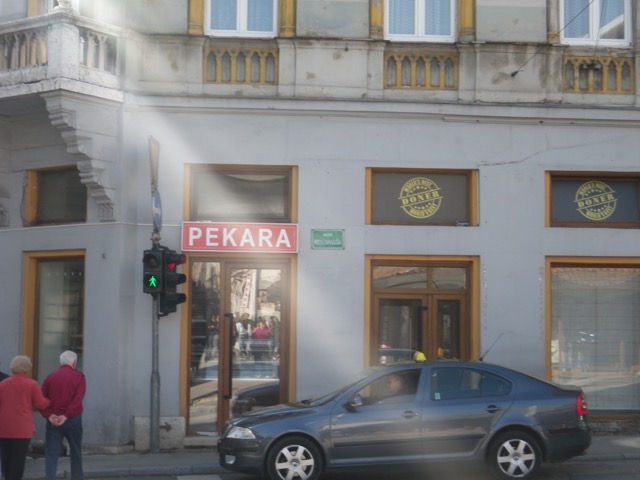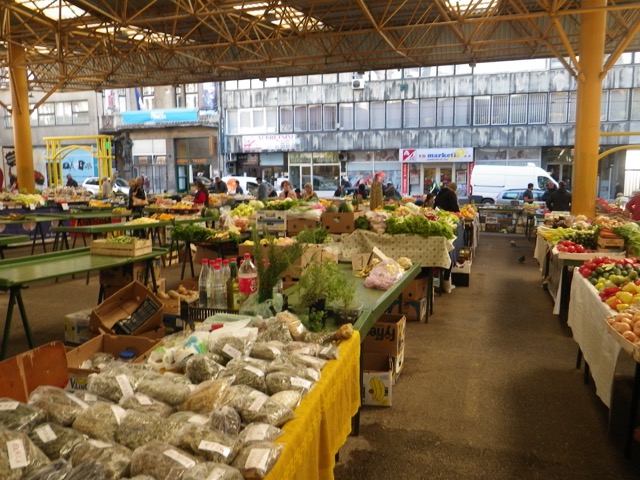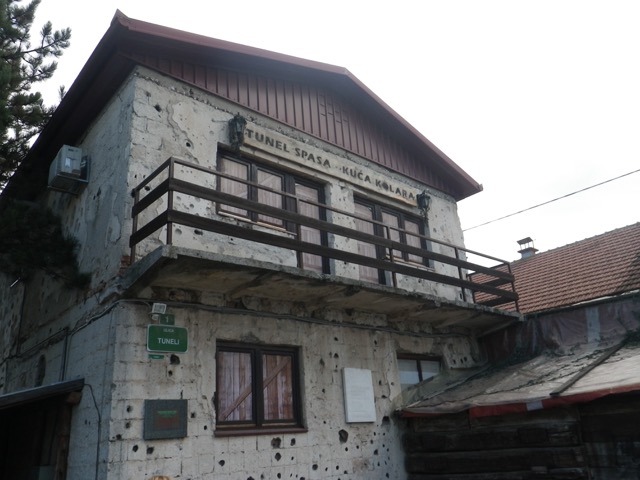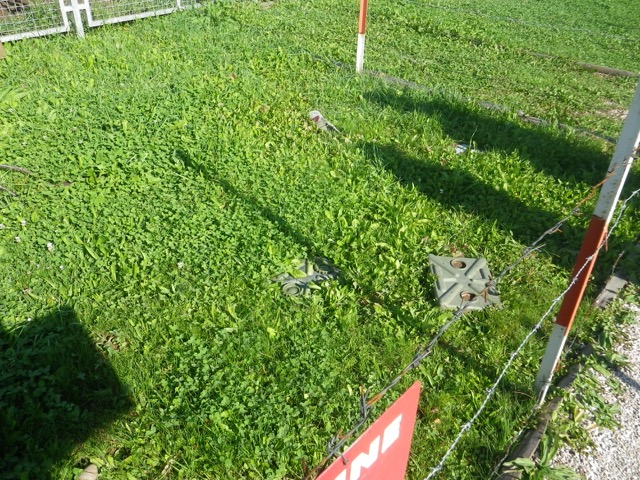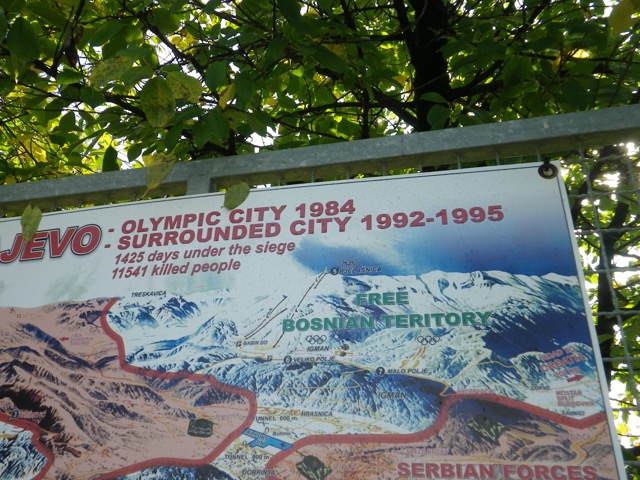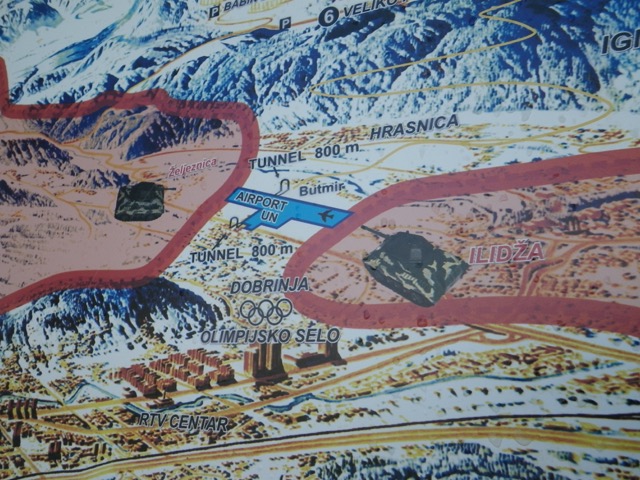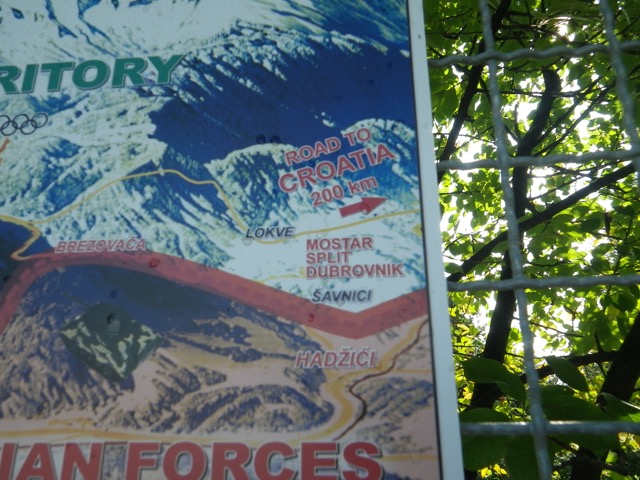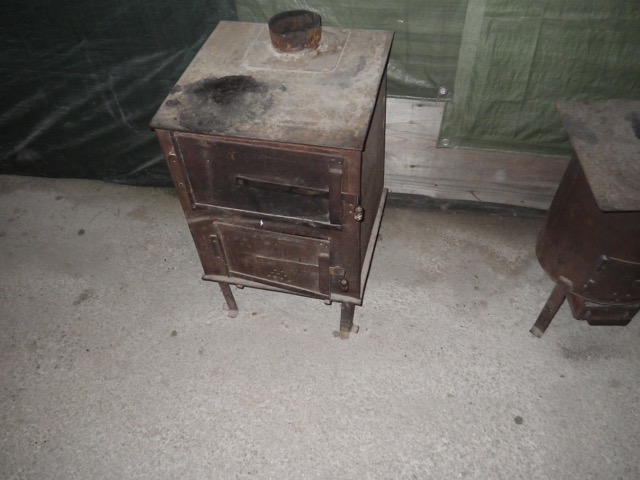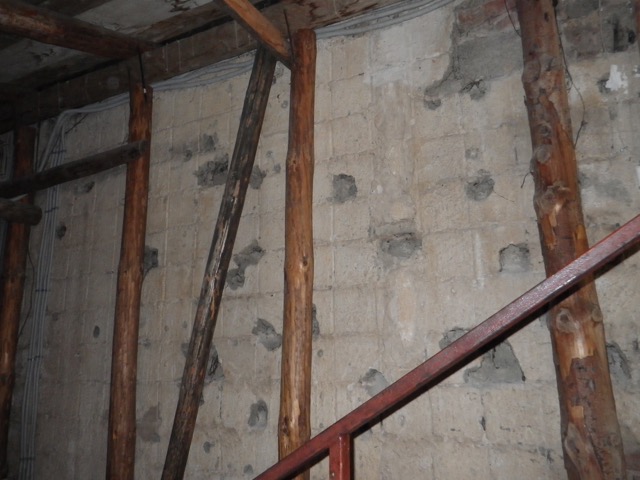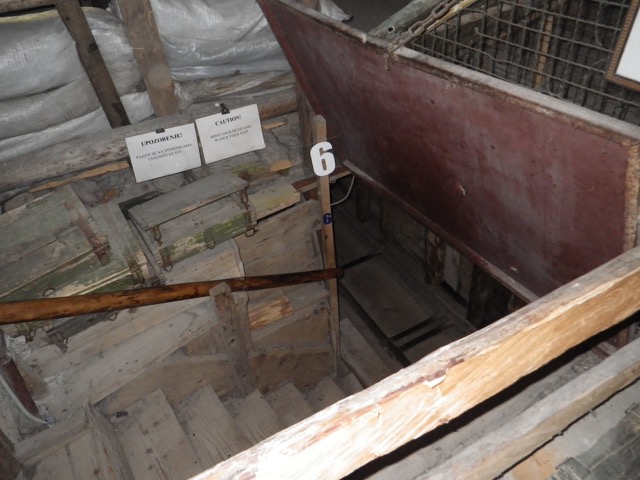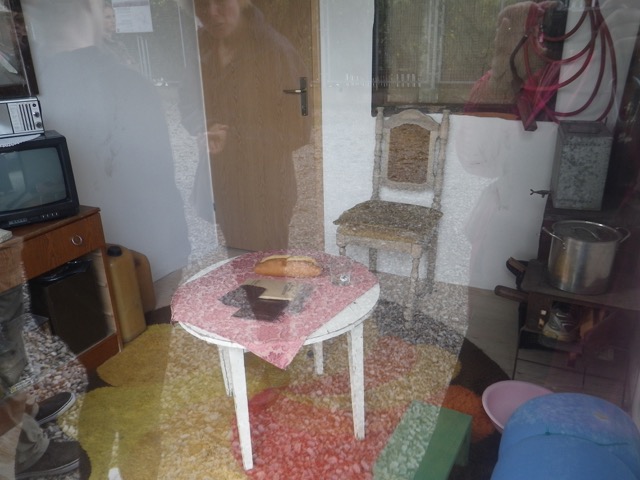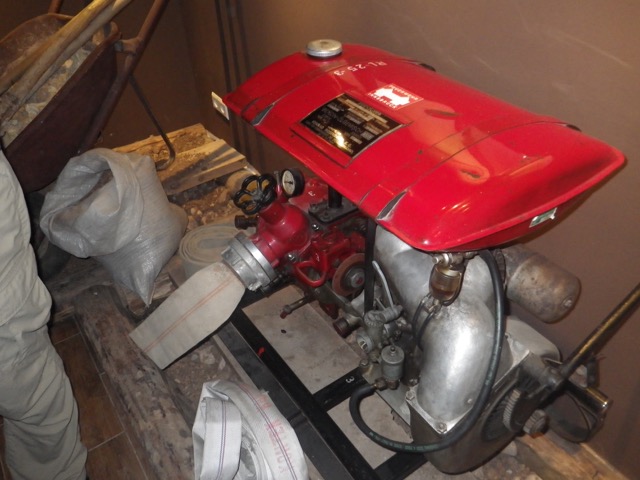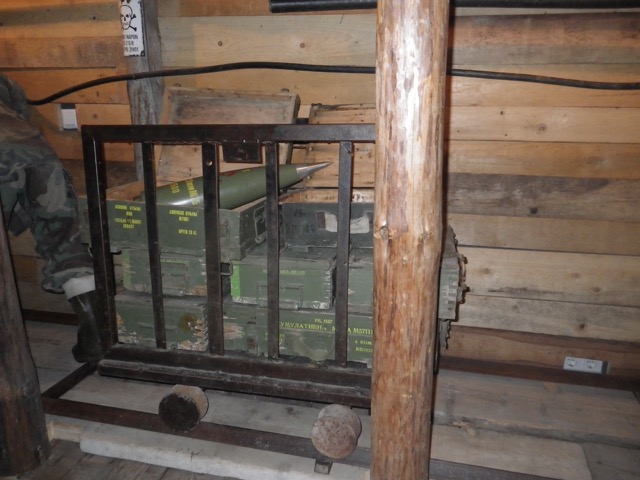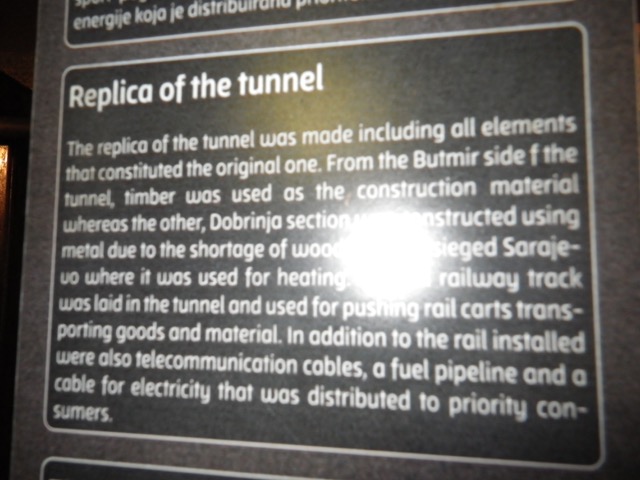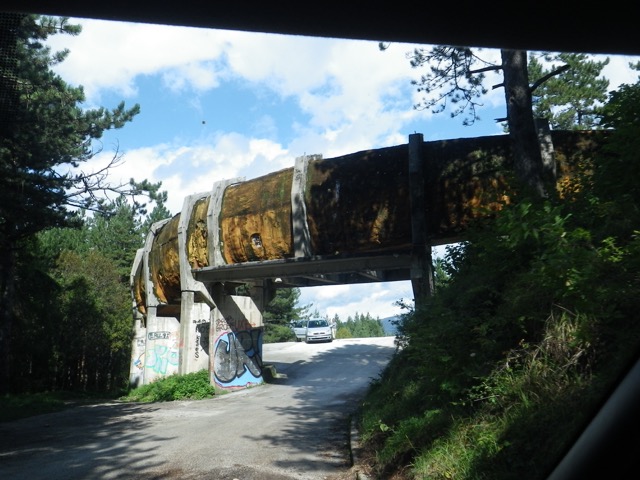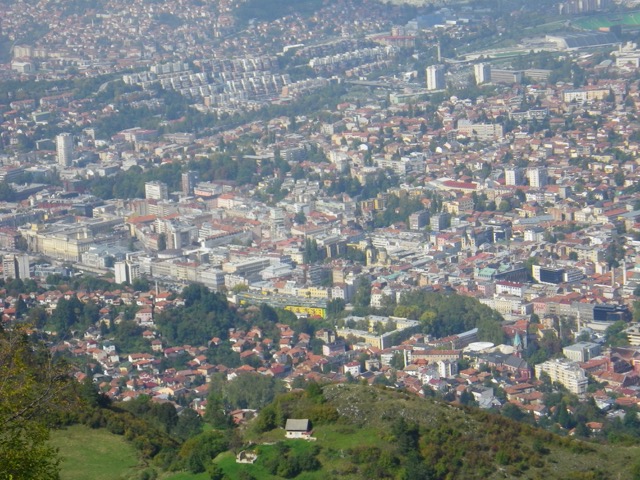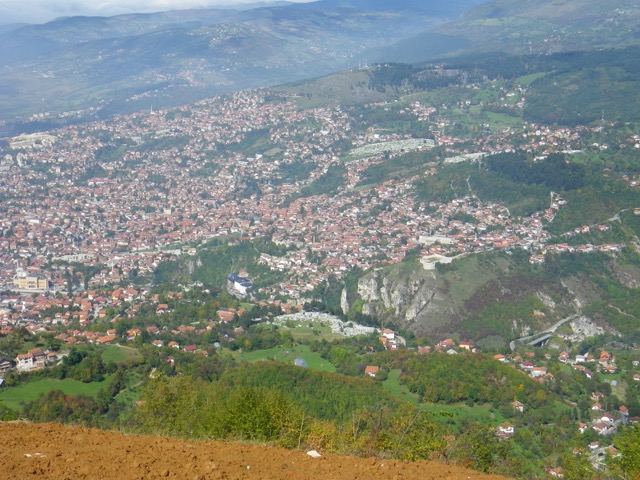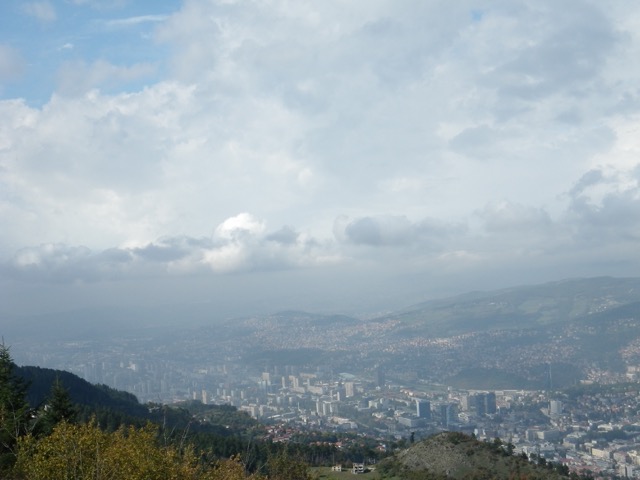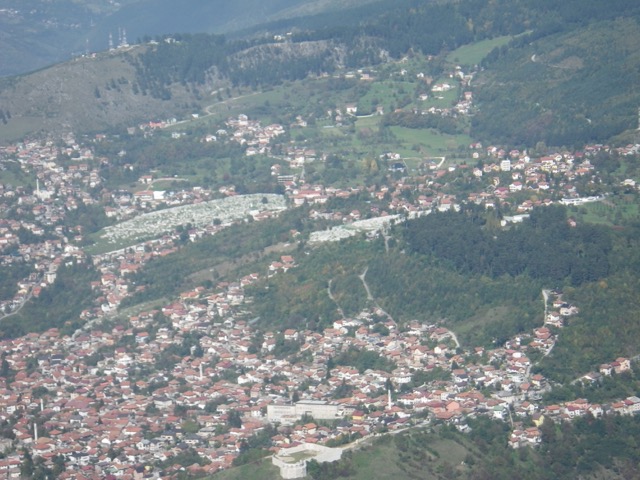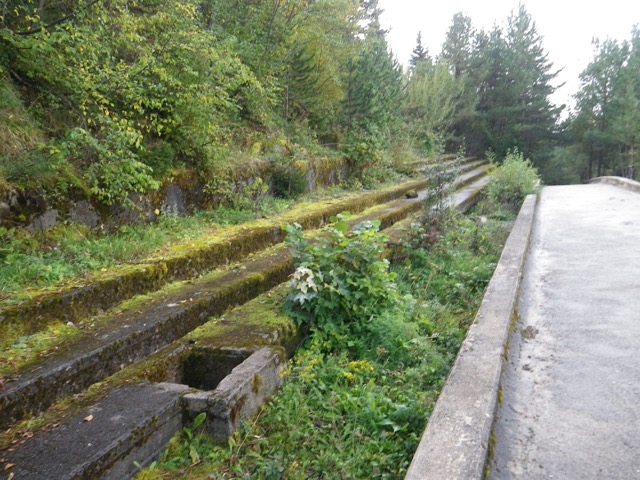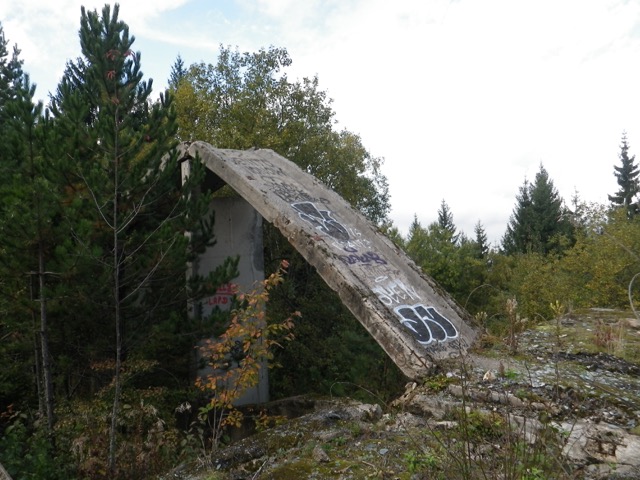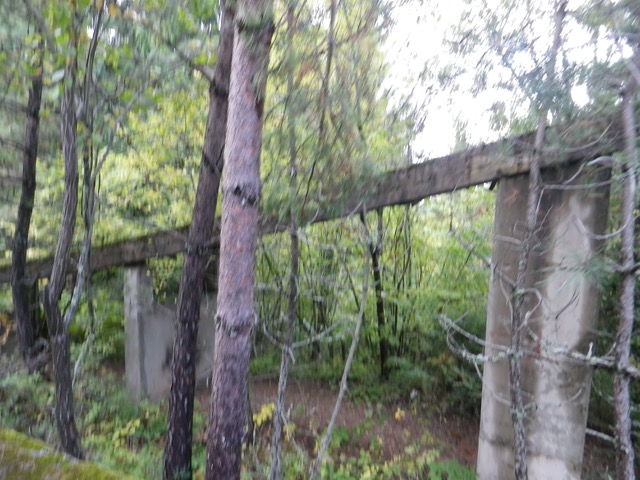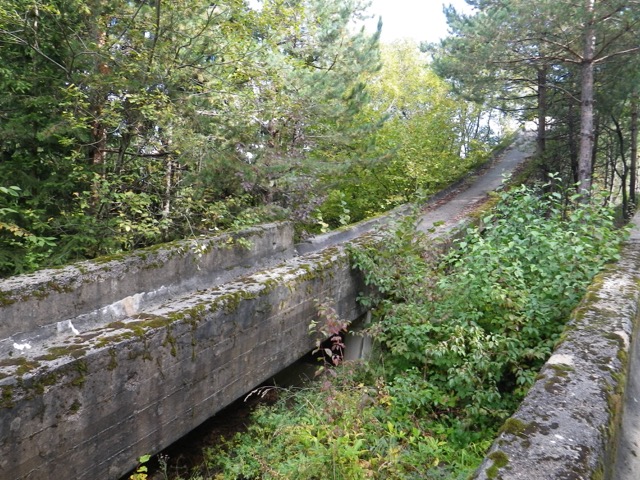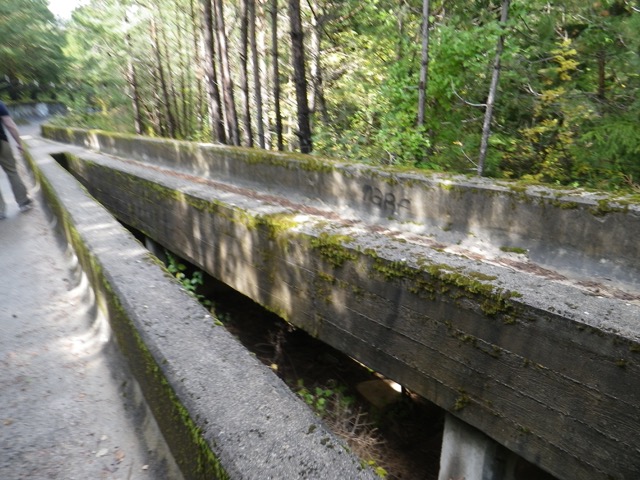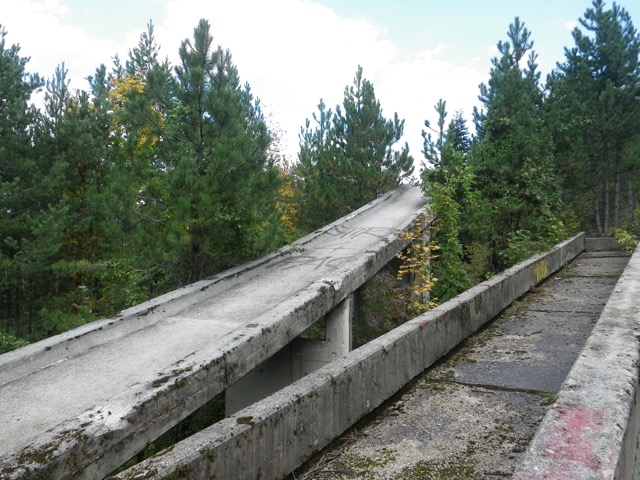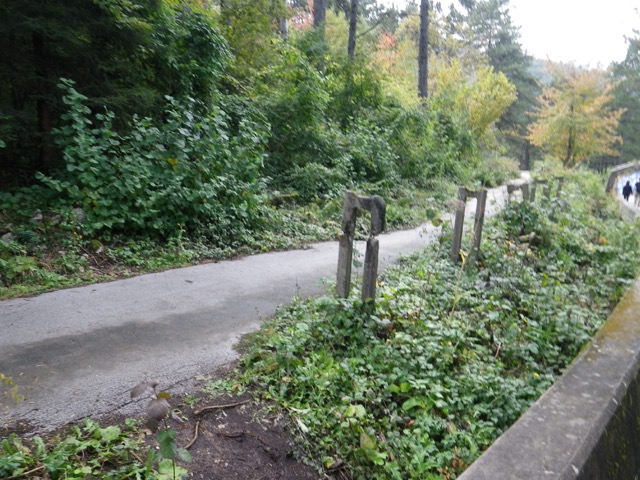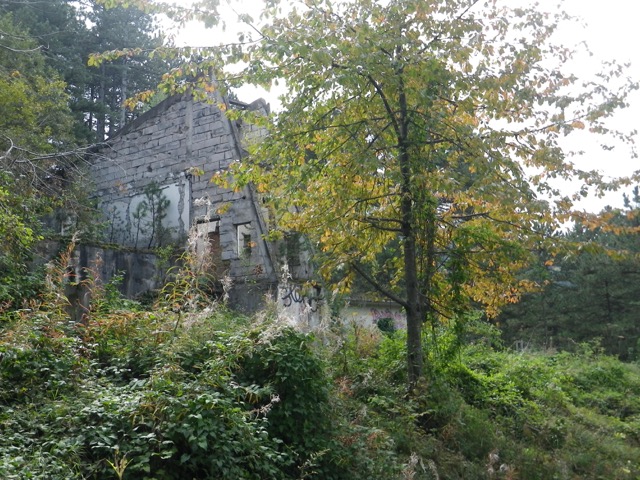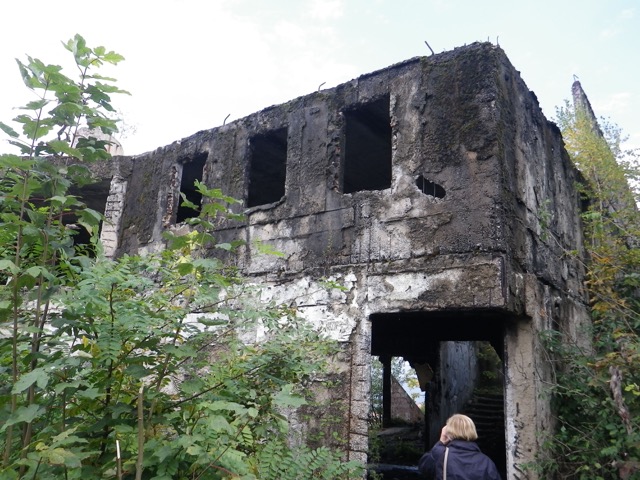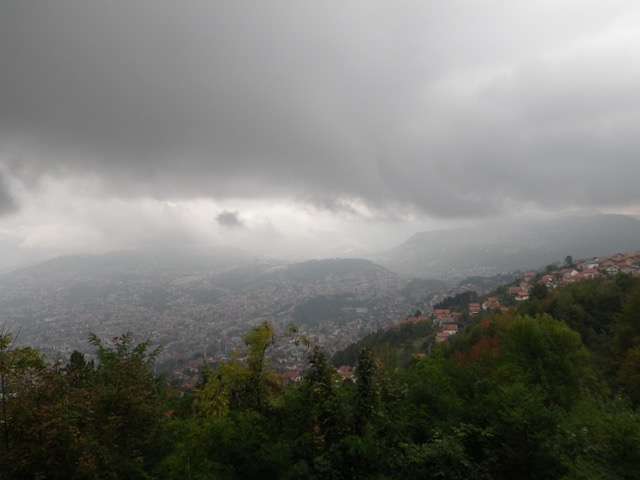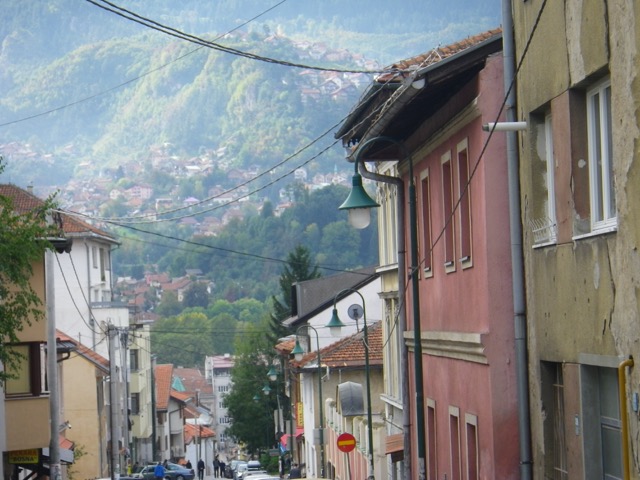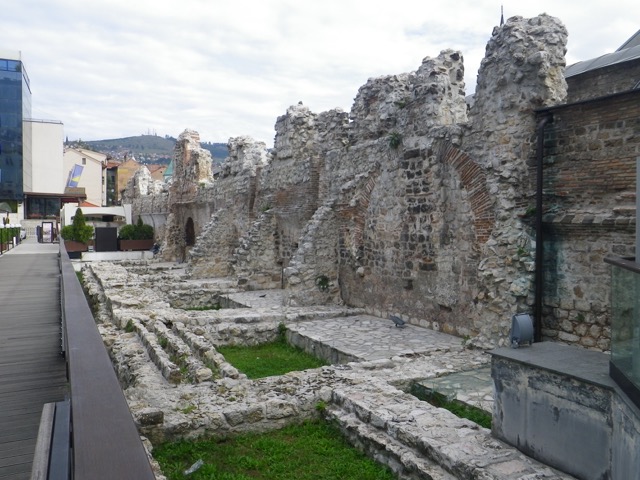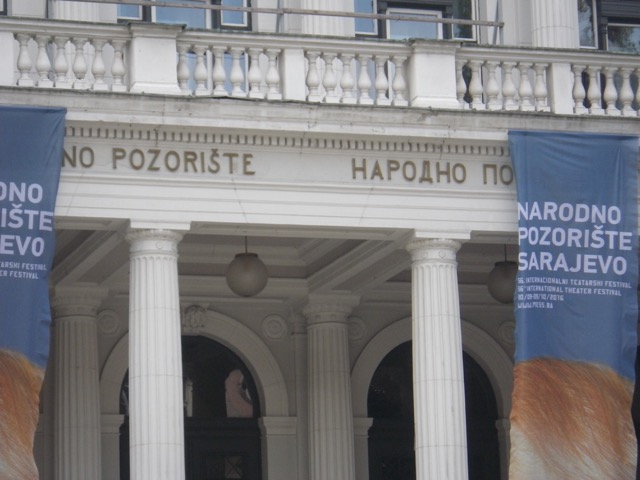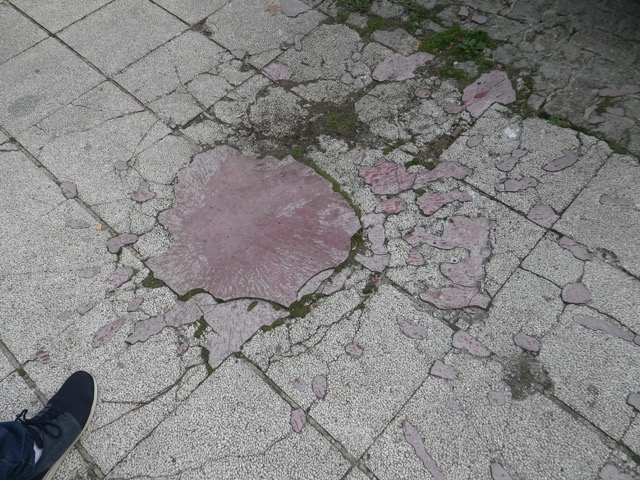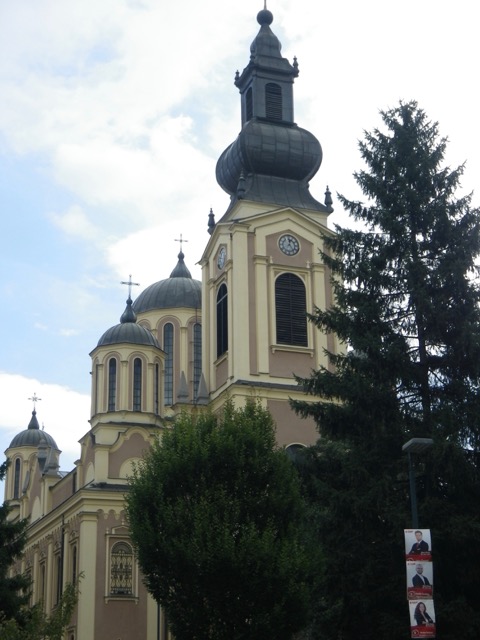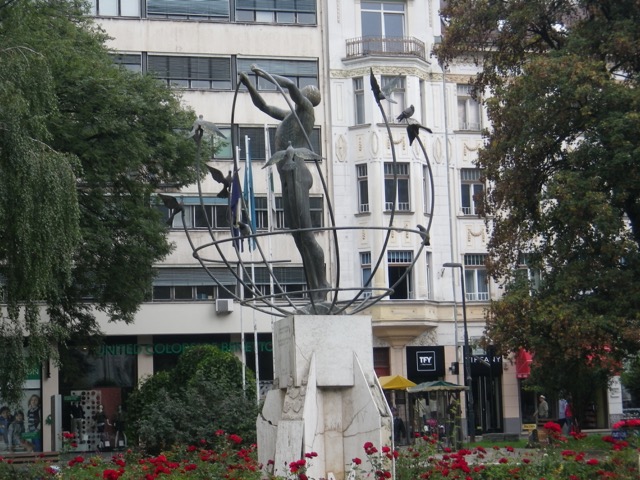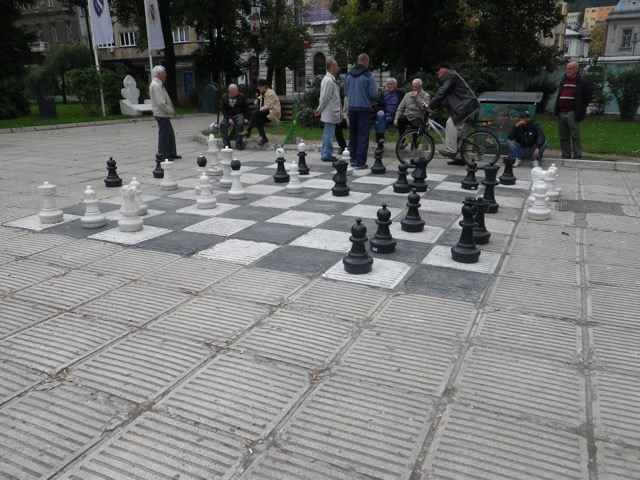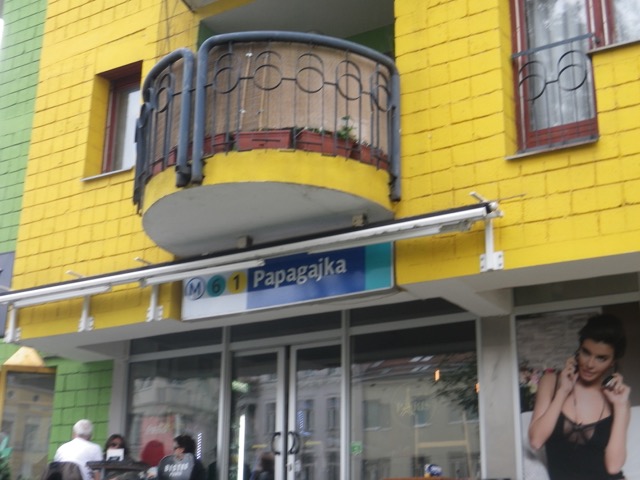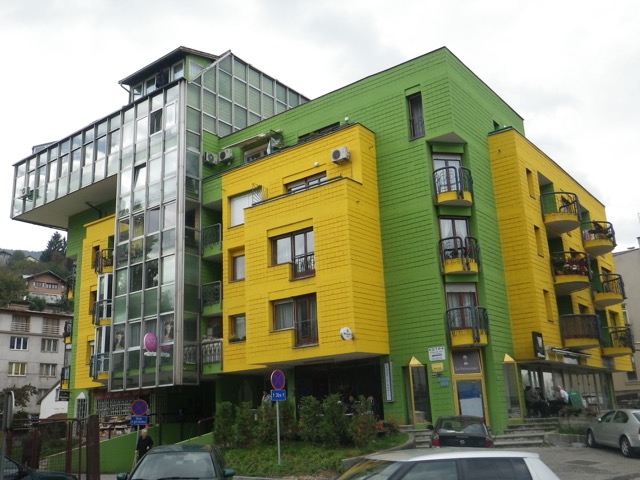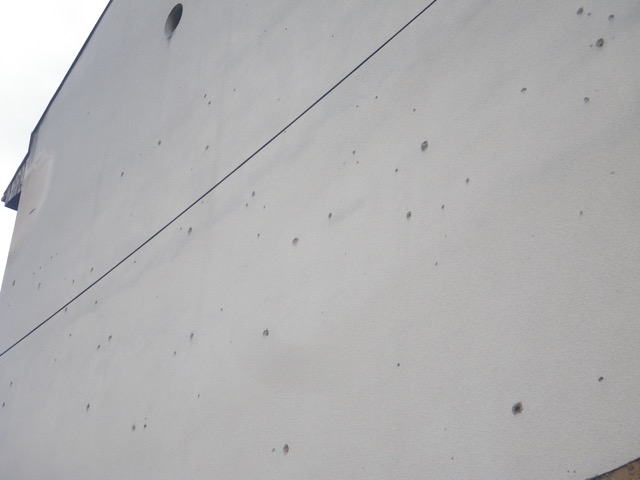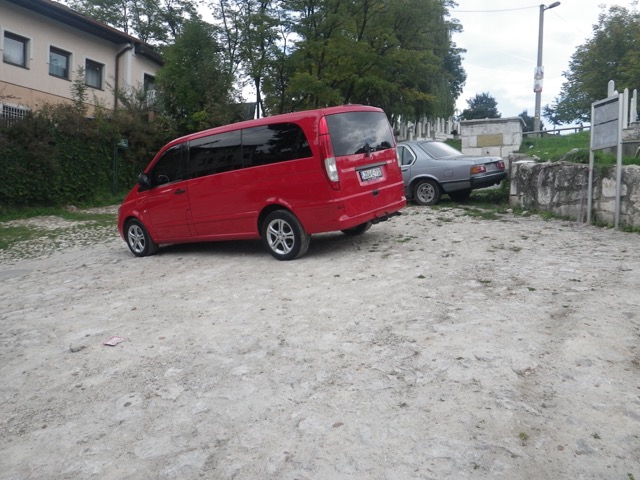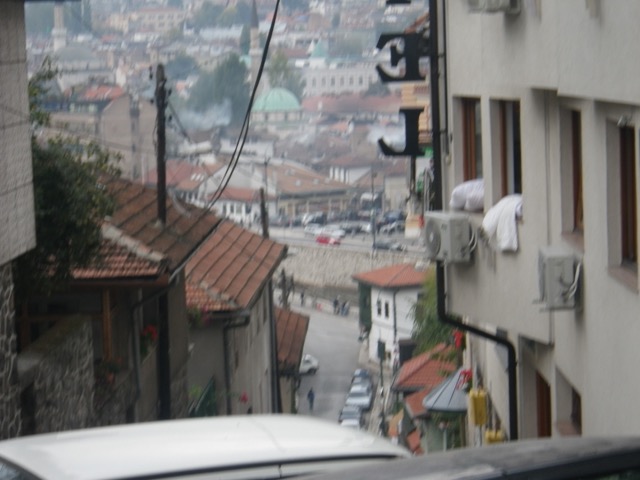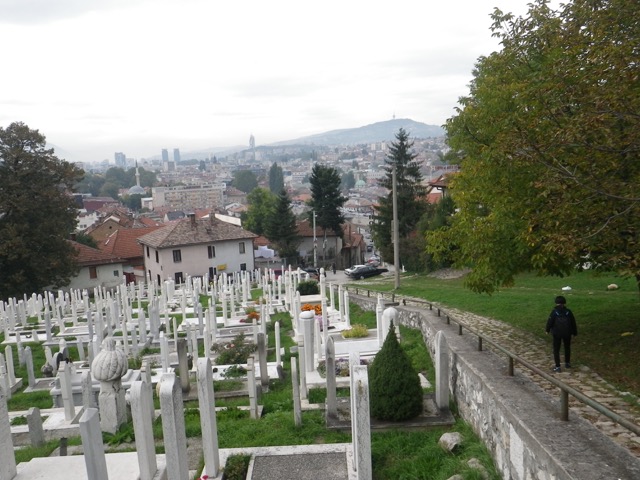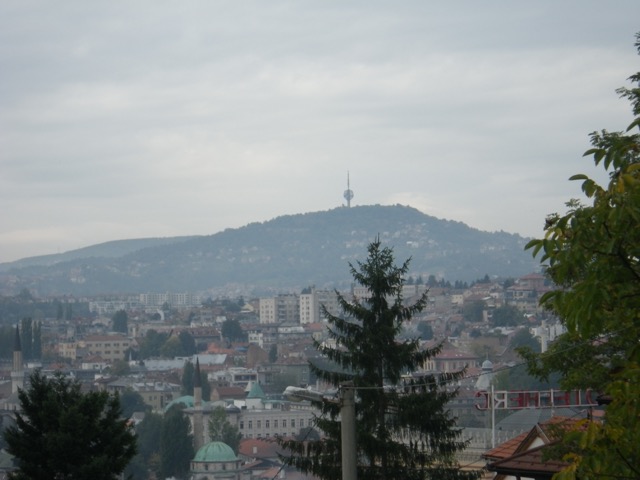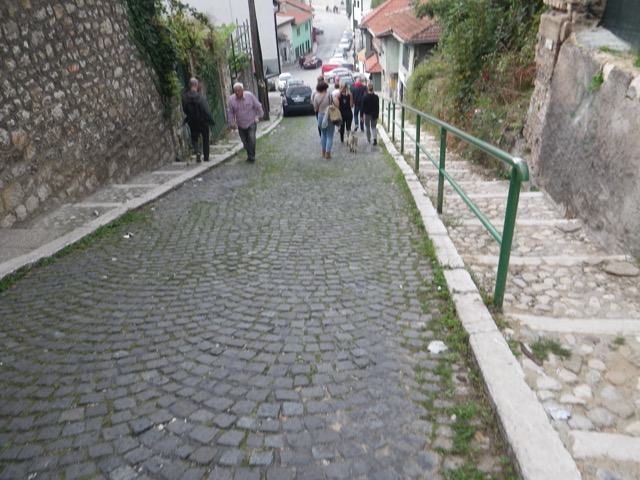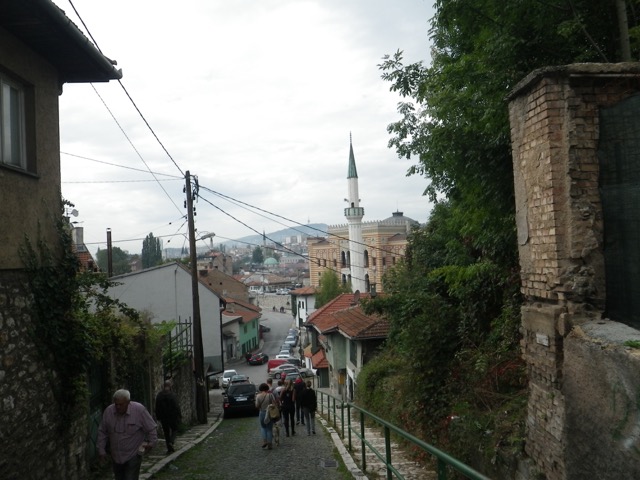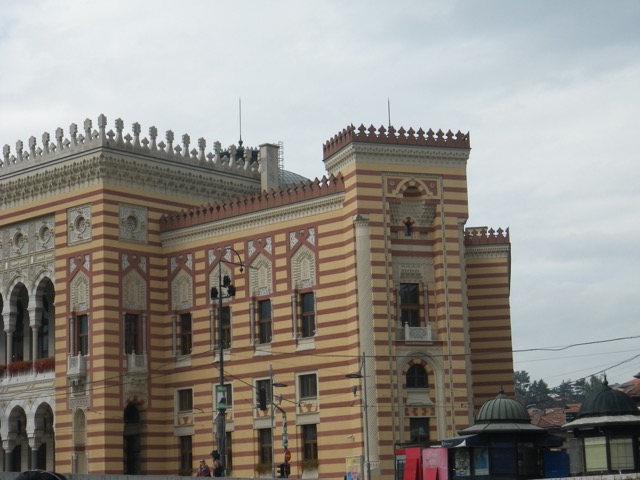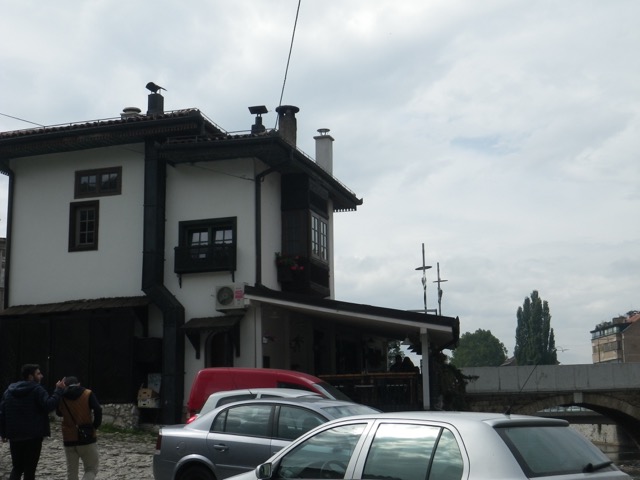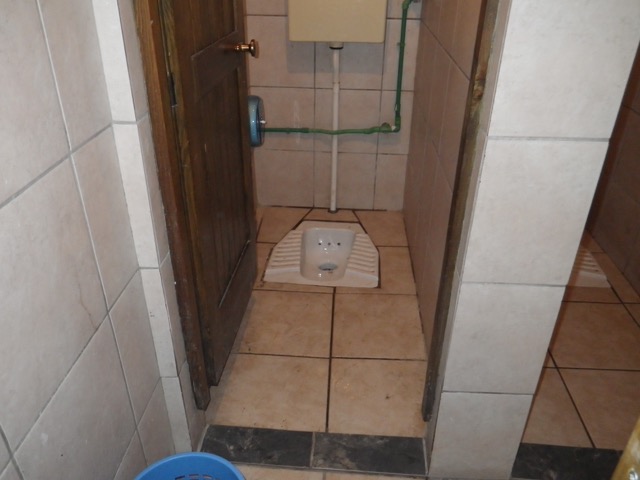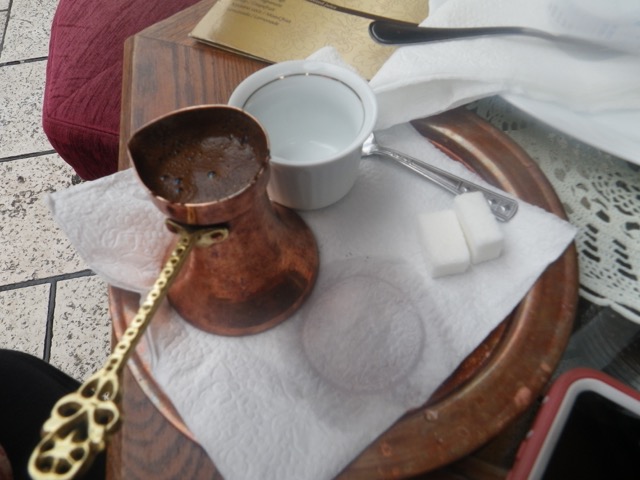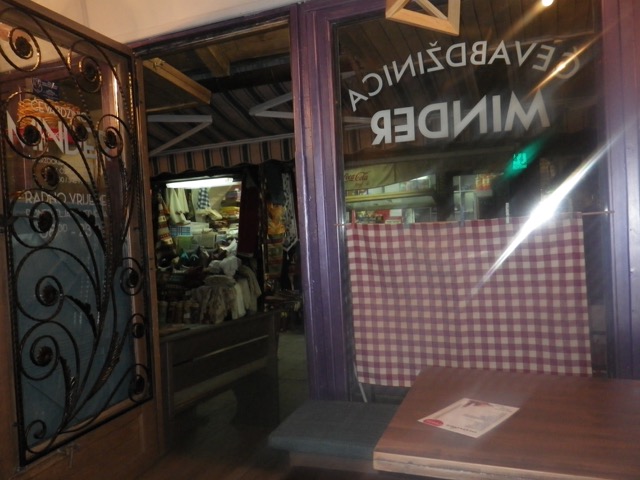I awoke to a super cold, grey, foggy, damp day. Yuck. Last thing I wanted to do was go exploring and I was so grateful I had heaps of work to do! By 12:30, I’d put in a full day of work, could call off with only one hour more to do in the evening, and the sun had come out! Talk about timing!
It was only 10C outside (brr!), so I pulled out my jeans for the first time and paired them with a long-sleeved top, fleece hoodie, and my cosy Tiek flats, my expected “fall weather” attire.
My first thought as I headed out was lunch and I wanted to try burek, “Bosnian pie.” I’d had no interest in it, but so many people told me I was nuts for not having had it and also pointed me to Buregdzinica Sac that I decided to try the experience today. I made a few wrong turns but eventually found the restaurant. The server spoke English and told me she had meat or potato, cheese, and spinach. So heads up, my vegetarian readers, there’s a burek for you!
I went with the meat and accepted sour cream, which was unfortunate since she drowned my pie. I ended up scraping it all off and only having what had soaked in. But you can’t really ever have too much sour cream, so my complaint is only that you didn’t get to see this pretty thing in all its glory. 🙂 It’s basically phyllo pastry that is assembled in a spiral and has filling mixed in.
My meat burek tasted like the Bosnian answer to tourtière, with heaps of savoury and perfectly seasoned meat mixed in with caramelised onions. Absolutely amazing. I might not have been a fan of Bulgarian and Serbian food, but Bosnian is great!
Then, I went back to the Baklava Shop to try their Nutella baklava and have the coffee I’d been craving all morning. The interior of the shop is so pretty. (pauses to listen to the adhan)
Next stop was Sarajevo City Hall as I was told the interior is impressive. It was devastated during the war and was rebuilt in stages.
Outside, there is a cable car and information on the plan to rebuild the cable car system to Trebević, the mountain I went up yesterday. Both of my tour guides are skeptical that it will happen and my guide yesterday reminisced fondly of taking the old cable car up the mountain with her family.
I was a bit surprised by the 5KM fee to enter city hall so I could take pictures, but figured that’s how they’re funding the reconstruction and, really, it’s a token amount. What I didn’t know is that city hall doubles as a museum and there are heaps of exhibits. So you get a lot of bang for your mark!
Austria-Hungary built the original city hall and felt it was their duty to help with the reconstruction. I’m trying to remember why Spain got involved, which I know one of my guides told me.
The ceiling mosaic. Wow!
One thing that I finally get after my two tours is why Sarajevans are so open to talking about the war and hold no punches. This is because they see themselves as victims, not as an equal culprits in the aggression. So when they talk about horrible events, they are not owning up to things that they did to themselves, but are pointing the finger at things that were done to them. That is my interpretation only and should not be taken as a judgement of the validity or not of this interpretation if it is accurate. But it makes a lot of sense and further helps me understand what happened here and why the impacts are so long-lasting.
City hall was the national library before becoming city hall again. It was the national library when it was bombed in the war. My guide yesterday said that this was an incomprehensible action by the Serbs because they were destroying their own heritage. Neno, from the walking tour, said that his grandmother still talks about seeing the ashes from all the books floating in the air.
This picture is of two soldiers on opposite sides of the war post-war at Srebrenica, site of the massacre of 8,000 Bosniak Muslims. I wonder what thoughts are going through their heads.
I was surprised by how much of city hall was open to visitors. Cordons and closed doors served as gentle guides telling us what areas were off limits.
This was a thorough exhibit about the history of city hall and Sarajevo in general. City hall was completed and opened in 1896. It was built in a pseudo-Moorish style, seen as a “cultural misunderstanding… regarded as a retarded form of foreign culture.”
Pardon the glare in these, but there’s too much information to just summarise it:
I saw video of the shelling in full colour. Tragic.
They began to rebuild almost immediately, just as it was one of the first major buildings to be destroyed.
There was an interesting section about the assassination of Archduke Ferdinand. The building that was a café and is now a museum has not changed much!
I was surprised that his marriage to Sophie Chotek was one of love and very controversial. She could not accompany him on official functions and their children could not inherit his title. To add a further sense of destiny to the assassination, it was the first time Sophie accompanied Franz Ferdinand on an official outing.
This photo of the lady running reminds me of something I forgot to share after the walk with Neno. He mentioned that his mother went to work in full makeup and heels even though her children begged her not to as she would not be able to outrun snipers. She said that she did so because she would be beautiful if she was left wounded on the street and also because there were reporters…
I learned yesterday, but forgot, that the peace accord was hammered out in Dayton, Ohio, of all places!
Those exhibits were essentially in the basement. I then went back to the main level and up to the first floor.
What am impressive building. I can understand how rebuilding it was important to Sarajevans and very likely boosted morale.
Next, I wanted to walk to New Sarajevo (across downtown down “Sniper Alley“) to photograph some of the things I saw on my tour yesterday. Sarajevo downtown is long and narrow as it is sandwiched by the mountains. There is a main thoroughfare that splits at the start of Old Town (Baščaršija), with traffic heading east passing south of Baščaršija along the river and traffic from the west passing to the north. Trolley cars go around Baščaršija in a loop. This map also happens to show the location of the brewery (pivara) across the river that I would visit later.
There are so many churches and mosques in this city that Sarajevo is known as Little Jerusalem.
Vicki, there are TONS of bakeries in Sarajevo. Look for signs that say “pekara”! 🙂
At the market I saw my first day, there is a memorial to the many dead in the war.
Loved the market!
Next up was the memorial to all the children killed in the war.
There’s a fountain but I just discovered I forgot to take a picture of it! There were fresh flowers all around it, with heartbreaking notes.
There was a row of these lists of names, births, and deaths. This is very much my generation.
I noticed this subtle bit of art on the sidewalk by the memorial.
The iconic (former) Holiday Inn. I remember seeing pictures of it after it was shelled because its yellow façade is so memorable. It was never a direct target.
A museum and I’m pretty sure something else even more important…
Our guide yesterday mentioned a building owned by a media magnate and I believe this is it. I stupidly stopped to take this picture in front of the huge US Embassy, but the guard who saw me do that did not speak up, so he must have realised I was not photographing the building.
I finally got to the building that so impressed me yesterday. Can you see the impact crater? This is just one of many.
Here’s another.
Without embiggening this picture, I can see at least three impact craters. How can the structure still be solid?! There’s a Costa Coffee on the ground floor, a major chain, so they must trust the building…
There was more I wanted to photograph, but I was getting tired and still had to walk back. I’d walked 3.5KM since city hall and had to walk it back. I could have taken the trolley, of course, but there was more I wanted to photograph on the return trip.
This is where the road splits as we come into Old Town.
This Courtyard Marriott is brand new.
This is the brand of coffee I bought the other day. There are billboards for it all over the city, so it must be popular. I don’t like it nearly as much as my usual brands, but it is very satisfactory, especially for the price.
By this point, I wanted a cold beer and decided to head to the Sarajevo Brewery, which for some reason wasn’t on my tourist map. I had a vague idea of where it was, but with the streets being as nonsensically laid out as they are, I knew I could wander around in circles for hours without getting to it. A half dozen, “Molim, pivo muzej?”s and pointing to passersby got me there. That’s, “Please, beer museum?” 😀
Entrance to the beer museum is 3KM, 5KM with a beer at the attached pub, or 25KM for lunch at the pub. I went with option two.
The museum was really tiny and was only about the history of the brewery, with no opportunity to actually visit its operations. I was rather disappointed.
Sarajevans boast about having the first café in Europe, but beer was slow to come.
Barrels were the most popular container for beer as for equal volume compared to bottles, the price was about 30% cheaper.
What a great painting of the brewery! Still looks like that.
This is the main newspaper in Sarajevo. We passed its building yesterday, but I didn’t get that far on foot.
The brewery had major operations until the start of the ’70s and then went into a steady decline. It continued with a token production during the war and was fully reconstructed and modernised after the war. There was a three-year contract with Coca-Cola to produce soft drinks, then a new contract was signed with PepsiCo.
The pub was dead, but pretty cosy.
It was rather a small beer and I wonder if I got taken as I have a hard time believing this was 2KM worth of beer (plus maybe a few sips as I think I’d tasted it by this time). This was a rather bitter lager, but tasty!
😀
I cut through the market to get home and made a purchase! My travel purse has been both a blessing and a curse. I love all the pockets in it and its generous size, but the overly padded straps tend to fall down my shoulders. I also miss not having a bag that I can wear cross-body, keeping my hands free, and in which I can stuff purchases. So it was inevitable that I would end up replacing the bag on my travels and decided I’d start shopping when my sewing job on the handles started to give way, which was here in Sarajevo. Now, this isn’t really a location to look for the kind of bag I wanted so there wasn’t a huge amount of choice. But as you know, I know what I like. 🙂
I’d seen this bag several times over the last few days and when I came upon it on the way across the market, I decided to ask about the price. I’d seen similar bags marked 30KM, which was way more than I was willing to pay. My budget was 20KM (about 15CAD). The storeowner came out of her shop almost the second I started prodding the bag and brought it down for me.
I loved the beading.
And the colour scheme.
She quickly showed me the pocket in the strap, which is brilliant. Shame it’s not just a tad wider so my phone could fit in it.
A zippered top is a must. I had to pass on a bag I loved even more because it didn’t have a zipper.
There’s also an interior pocket for things I need to keep handy. I will miss not having more pockets, but one is better than none.
The price was 25KM. but I noticed a slight imperfection in the stitching on the front, so I wasn’t willing to stretch my budget because I will need to fix it as the whole beaded panel could unravel. The clerk showed me other bags in the same style, but I found them hideous. After I passed on two or three of those, she pointed to the bag I liked, crossed out the 25 she’d written down and wrote, “20?” Yes, perfect! We were both very happy. 🙂
I bought dinner stuff and then headed up the hill, which felt about twice as steep as it did the other days. Boy was I tired!
For dinner, I put together a quick pasta that was the best pasta and sauce combo I’ve had since I got to the Balkans! I found these fresh Bosnian noodles and tossed them with a sauce that’s meant to be used as a dip that had much more complex flavours than any of the Italian jarred sauces I’ve tried.
Tomorrow was supposed to be my last day in Sarajevo, but a large work order came in, so I am staying till Saturday! This is a blessing because my next destination is expensive and will be difficult to get to, so I can travel there over a couple of days if I want to and then not feel like I have to take a private room with shared bathroom to save some money. I have to say that my last two weeks in the Balkans are growing murkier rather than clearer and that I’m no closer to knowing from where I’ll be flying to Madrid!
I think I’m done with tourism in Sarajevo because I have three solid days of work to do. I will venture out tomorrow to get groceries (and possibly a coffee if I go early enough), but the plan is to stay in all of Thursday with the hope of being able to finish early enough on Friday to hit a few museums. Somewhere in all of that, I will find time for another slice of Bosnian pie. I’d love to find the one with butternut squash!



